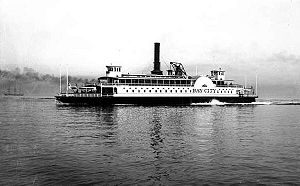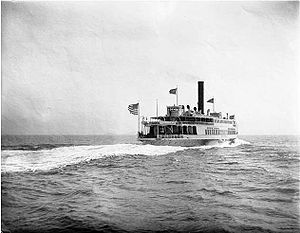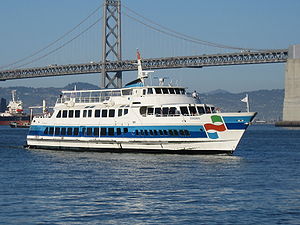Ferries of San Francisco Bay
San Francisco Bay in California has been served by ferries of all types for over 150 years. Although the construction of the Golden Gate Bridge and the San Francisco – Oakland Bay Bridge led to the decline in the importance of most ferries, some are still in use today for both commuters and tourists.
Contents
The Creek Route ferries
One of the earliest ferry routes ran between San Francisco and Oakland on what was called the "creek route". The name derived from the Oakland landing site located at the foot of Broadway where Jack London Square is today, fronting on what is today called the Oakland Estuary, an inlet of San Francisco Bay. The estuary, which in the 1800s included what is today's Lake Merritt, was the "creek". In 1850, Captain Thomas Gray, grandfather of the famous dancer Isadora Duncan, began the first regular ferry service to San Francisco from the East Bay. [1] His boat was a small steamer, the Kangaroo.[2]
Railroad ferries
The first railroad ferries on San Francisco Bay were established by the San Francisco and Oakland Railroad and the San Francisco and Alameda Railroad which were taken over by the Central Pacific Railroad and became an integral part of the First Transcontinental Railroad. The earliest railroad ferries ran from Oakland Point and from Alameda Terminal when Alameda when was still a peninsula. The ferry pier at Oakland Point was greatly enlarged to form the Oakland Long Wharf. These railroad ferries mostly carried passengers, not trains, although there was some ferrying of freight cars to San Francisco. When the Central Pacific re-routed the Sacramento to Oakland segment of the Transcontinental Railroad in 1876, a ferry across the Carquinez Strait was established, and the world's largest ferryboat, the Solano was built (later joined by a sister ferry, the slightly larger Contra Costa), to serve the crossing. This railroad ferry actually carried whole trains. These ferries became part of the Southern Pacific Railroad when it assumed many of the facilities of its affiliate, the Central Pacific.
The Key System transit company established its own ferry service in 1903 between the Ferry Building in San Francisco and its own pier and wharf ("mole") on the Oakland shoreline, located just south of what is today the eastern approach to the San Francisco – Oakland Bay Bridge.
Ferries began serving north bay rail connections with the Petaluma and Haystack Railroad in 1864. San Francisco and North Pacific Railroad (SF&NP) and Petaluma and Santa Rosa Railroad[3] ferries connected Petaluma River landing locations with San Francisco. North Pacific Coast Railroad ferries connected Sausalito[4] with San Francisco, and SF&NP ferries later sailed from Tiburon. Some of these ferries operated on Northwestern Pacific Railroad schedules from 1907 until the Golden Gate Bridge opened.[5]
Auto ferries
In the 1920s, the Southern Pacific Railroad established a subsidiary, the Golden Gate Ferries, to carry automobiles on three routes: the Golden Gate between the Hyde Street Pier in San Francisco and Sausalito in Marin County; San Francisco Bay between the Hyde Street Pier and the Berkeley Pier; and San Francisco Bay between San Francisco and the Oakland Pier. Another auto ferry pier operated at the foot Broadway. These ferries ceased operation shortly after the Golden Gate and Bay Bridges were opened.
Air Ferries
In 1914, a short-lived seaplane ferry ran between San Francisco and Oakland. From 1930 to 1933, a more successful transbay seaplane ferry was operated by Air Ferries Ltd. It ran from Pier 5 on the San Francisco waterfront to a shoreline barge docked at the foot of Franklin Street along the Oakland Estuary. It also operated between San Francisco and Vallejo. A fatal accident in 1933 put an end to the service.[6]
During the 1960s, SFO Helicopter transported passengers to and from the San Francisco and Oakland airports from various locales around the bay including the San Francisco waterfront and the Berkeley Marina.
Ferries today
The largest ferry system on San Francisco Bay today is operated by Blue & Gold Fleet. Others include Red & White Fleet and Golden Gate Transit. Modern high speed ferryboats of this commuter system run between the Ferry Building in San Francisco and landings in Sausalito and Larkspur in Marin County.
Other commuter ferries run from the city of Alameda and Jack London Square in Oakland by Oakland-Alameda Ferry and Vallejo to the Ferry Building in San Francisco by Baylink Ferry.
Tourist ferries run from Fisherman's Wharf to Alcatraz Island, and from Sausalito to Angel Island.
List of ferryboats on San Francisco Bay
Past
- Alameda (Southern Pacific, 1911–47)
- Antelope (SF&NP 1871-1888)[5]
- Bay City (Southern Pacific)
- Berkeley (Southern Pacific)
- Cazadero (North Shore Railroad/Northwestern Pacific 1903-1941)[4]
- City of Long Beach[7]
- City of Sacramento (Monticello Steamship Lines, Southern Pacific-Golden Gate Ferries)[8]
- Clinton (North Pacific Coast Railroad 1853-1877)[4]
- Contra Costa (North Pacific Coast Railroad 1857-1882)[4]
- Contra Costa (Central Pacific/Southern Pacific 1914-1930)
- Eureka (Northwestern Pacific/Southern Pacific 1922-preserved at San Francisco Maritime National Historical Park)[4]
- Fresno (Southern Pacific)[9]
- General Frank M. Coxe (US Army)
- Gold (Petaluma and Santa Rosa Railroad 1883-1920)[3]
- Gold (Petaluma and Santa Rosa Railroad 1921-1935)[3]
- Golden Gate (Golden Gate)
- Hayward (Key System)
- James M. Donahue (SF&NP/Northwestern Pacific 1875-1921)[5]
- Kangaroo (Thomas Gray)
- Lagunitas (North Shore Railroad/Northwestern Pacific 1903-1921)[4]
- Marin (SF&NP/Northwestern Pacific 1909-1934)[5]
- Mendocino (Northwestern Pacific 1927-1939)[5]
- Newark (Southern Pacific)
- Oakland (Southern Pacific)
- Ocean Wave (Santa Fe)
- Peralta (Key System)
- Petaluma (Petaluma and Santa Rosa Railroad 1884-1914)[3]
- Petaluma (Petaluma and Santa Rosa Railroad/Northwestern Pacific 1914-1956)[3]
- Redwood Empire (Northwestern Pacific 1927-1939)[5]
- San Leandro (Key System/Southern Pacific)[9]
- San Pablo (Santa Fe)
- San Pedro (Santa Fe)
- San Rafael (North Pacific Coast Railroad 1877-1901)[4]
- Santa Clara (Southern Pacific, 1913–47)
- Santa Rosa (Northwestern Pacific 1927-1939)[5]
- Saucelito (North Pacific Coast Railroad 1877-1884)[4]
- Sausalito (North Pacific Coast Railroad/North Shore/Northwestern Pacific 1894-1932)[4]
- Solano (Central Pacific/Southern Pacific)
- Stockton (Southern Pacific-Golden Gate Ferries)
- Tamalpais (North Pacific Coast Railroad 1857-1900)[4]
- Tamalpais (North Pacific Coast Railroad/North Shore/Northwestern Pacific 1901-1947)[4]
- Tiburon (SF&NP/Northwestern Pacific 1884-1925)[5]
- Yerba Buena (Key System)
Present
- Bay Breeze (Alameda Harbor Bay)
- Chinook (Golden Gate - not yet in service)
- Del Norte (Golden Gate)
- Encinal (Alameda/Oakland)
- Gemini (Alameda/Oakland)
- Intintoli (Vallejo Baylink)
- Marin (Golden Gate)
- Mare Island (Vallejo Baylink)
- Mendocino (Golden Gate)
- Napa (Golden Gate)
- Peralta (Alameda/Oakland)
- Pisces (Alameda/Oakland)
- San Francisco (Golden Gate)
- Solano (Vallejo Baylink)
- Sonoma (Golden Gate)
- Vallejo (Vallejo Baylink)
- Zelinsky (Blue and Gold)
Old Ferries, New Locales
At least seven ferries that had seen service on San Francisco Bay were relocated. Seven were purchased by the Puget Sound Navigation Company and went on to serve in the waters of northwestern Washington and southwestern British Columbia: the City of Sacramento, which operated on the Seattle-Bremerton route in the 1940s, then on the Horseshoe Bay-Nanaimo route from 1952 to 1963 as the MV Kahloke, and finally on the Horseshoe Bay-Langdale route from 1964 to 1976 as the MV Langdale Queen; the Peralta, rebuilt as the Kalakala, on various Puget Sound crossings and on the Seattle-Victoria-Port Angeles route; the City of Long Beach, renamed the City of Angeles, which operated out of Port Angeles; and the Stockton, which became the Klickitat and operated on the Keystone-Port Townsend route until 2007. Mendocino (renamed Quinault) and Redwood Empire (renamed Nisqually) were retired in 2003 and scrapped in 2009. Santa Rosa was renamed Enetai, returned to San Francisco Bay in 1968, and is preserved at Pier 3.[5]
Notes
- ↑ Port of Oakland-History
- ↑ Forgotten Pioneers: Irish Leaders in Northern California, Thomas F. Prendergast, The Minerva Group, Inc., 2001, p.261
- ↑ 3.0 3.1 3.2 3.3 3.4 Stindt (1985) p.128
- ↑ 4.00 4.01 4.02 4.03 4.04 4.05 4.06 4.07 4.08 4.09 4.10 Dickson (1974) p.139
- ↑ 5.0 5.1 5.2 5.3 5.4 5.5 5.6 5.7 5.8 Stindt (1978) p.256
- ↑ History Net, Jay Wright (1998?)
- ↑ Little-known ferries of Puget Sound
- ↑ History of the MV Langdale Queen, ex-MV Kahloke, ex-SS City of Sacramento, ex-SS Asbury Park
- ↑ 9.0 9.1 Peter Fimrite (2005-04-28). "Ferry tale -- the dream dies hard: 2 historic boats that plied the bay seek buyer -- anybody". San Francisco Chronicle. http://www.sfgate.com/cgi-bin/article.cgi?f=/c/a/2005/04/28/BAG8BCGI3I1.DTL&hw=ferry&sn=310&sc=862. Retrieved 2007-10-31.
References
- Dickson, A. Bray (1974). Narrow Gauge to the Redwoods. Trans-Anglo Books. ISBN 0-87046-010-2.
- San Francisco Bay: A Pictorial Maritime History, by John Haskell Kemble, Bonanza Books (1957, 1978).
- San Francisco Bay Ferryboats, by George H. Harlan, Howell-North Books (1967).
- Stindt, Fred A. (1978). The Northwestern Pacific Railroad. Stindt, Fred A..
- Stindt, Fred A. (1985). The Northwestern Pacific Railroad, Volume Two. Fred A. Stindt. ISBN 0-9615465-0-6.
External links
- Golden Gate Transit
- Alameda/Oakland/San Francisco Ferry official website
- Baylink (official Vallejo ferry website)
- San Francisco Bay Ferryboats
- "So Where Are They Now? The Story of San Francisco’s Steel Electric Empire". Bay Crossings. http://www.baycrossings.com/archives/2002/04_May/so_where_are_they_now.htm.
- Cable Car Guy - list of preserved historical ferries of San Francisco Bay
| ||||||||||||||||||||



